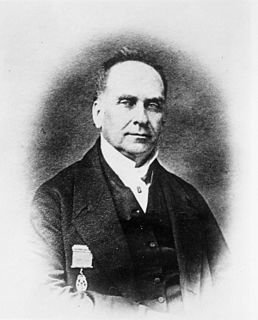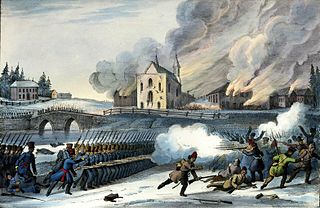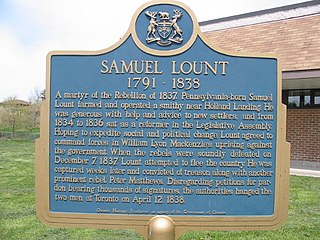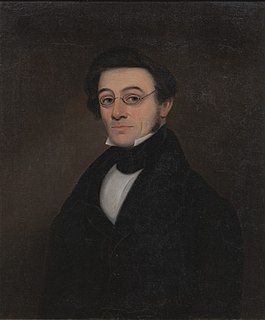Related Research Articles

The Province of Canada was a British colony in North America from 1841 to 1867. Its formation reflected recommendations made by John Lambton, 1st Earl of Durham, in the Report on the Affairs of British North America following the Rebellions of 1837–1838.

Robert Baldwin was an Upper Canadian lawyer and politician who with his political partner Louis-Hippolyte Lafontaine of Lower Canada, led the first responsible government ministry in the Province of Canada. "Responsible Government" marked the province's democratic self-government, without a revolution, although not without violence. This achievement also included the introduction of municipal government, the introduction of a modern legal system and the Canadian jury system, and the abolishing of imprisonment for debt. Baldwin is also noted for feuding with the Orange Order and other fraternal societies. The Lafontaine-Baldwin government enacted the Rebellion Losses Bill to compensate Lower Canadians for damages suffered during the Lower Canada Rebellion of 1837–1838. The passage of the Bill outraged Anglo-Canadian Tories in Montreal, resulting in the burning of the Parliament Buildings in Montreal in 1849.

The Lower Canada Rebellion, commonly referred to as the Patriots' War in French, is the name given to the armed conflict in 1837–38 between rebels and the colonial government of Lower Canada. Together with the simultaneous rebellion in the neighbouring colony of Upper Canada, it formed the Rebellions of 1837–38.

The Upper Canada Rebellion was an insurrection against the oligarchic government of the British colony of Upper Canada in December 1837. While public grievances had existed for years, it was the rebellion in Lower Canada, which started the previous month, that emboldened rebels in Upper Canada to revolt.

The Legislative Assembly of Upper Canada was the elected part of the legislature for the province of Upper Canada, functioning as the lower house in the Parliament of Upper Canada. Its legislative power was subject to veto by the appointed Lieutenant Governor, Executive Council, and Legislative Council.
The 8th Parliament of Upper Canada was opened 31 January 1821. Elections in Upper Canada had been held in July 1820. All sessions were held at York, Upper Canada and sat in the second Parliament Buildings of Upper Canada. This parliament was dissolved 22 June 1824.
The 12th Parliament of Upper Canada was opened 15 January 1835. Elections in Upper Canada had been held in October 1834. All sessions were held at York, Upper Canada. This parliament was dissolved 28 May 1836 by the new Lieutenant Governor, Sir Francis Bond Head. Head ordered a new election because the House of Assembly, dominated by reformers, had refused to pass any new money bills. The assembly also labelled Head a deceitful tyrant after he had invoked his right to consult them only on certain specific matters. It was succeeded by the 13th Parliament of Upper Canada in November 1836.

Samuel Lount was a blacksmith, farmer, magistrate and member of the Legislative Assembly in the province of Upper Canada for Simcoe County from 1834 to 1836. He was an organizer of the failed Upper Canada Rebellion of 1837, for which he was hanged as a traitor. His execution made him a martyr to the Upper Canadian Reform movement.

Thomas David Morrison was a doctor and political figure in Upper Canada. He was born in Quebec City around 1796 and worked as a clerk in the medical department of the British Army during the War of 1812. He studied medicine in the United States and returned to York in 1824 to become a doctor in Upper Canada. He treated patients and served on the Toronto Board of Health during the 1832 and 1834 cholera outbreaks and co-founded the York Dispensary. In 1834 he was elected to the 12th Parliament of Upper Canada, representing the third riding of York County as part of the reform movement. That same year he was elected as an alderman to the Toronto City Council and reelected the subsequent two years. In 1836, he served a term as mayor of Toronto.
The Legislative Assembly of the Province of Canada was the lower house of the legislature for the Province of Canada, which consisted of the former provinces of Lower Canada, then known as Canada East and later the province of Quebec, and Upper Canada, then known as Canada West and later the province of Ontario. It was created by The Union Act of 1840. Canada East and Canada West each elected 42 members to the assembly. The upper house of the legislature was called the Legislative Council.

John Solomon Cartwright, was a Canadian businessman, lawyer, judge, farmer and political figure in Kingston, Upper Canada. He was a supporter of the Family Compact, an oligarchic group which had dominated control of the government of Upper Canada through their influence with the British governors. He was also a member of the Compact Tory political group, first in the Legislative Assembly of Upper Canada, and then in the Legislative Assembly of the Province of Canada.
John Prince, was a lawyer, militia officer, gentleman farmer and political figure in Upper Canada and Canada West.
Thomas Parke was an architect, builder, journalist and political figure in Upper Canada.

The Parliament of the Province of Canada was the legislature for the Province of Canada, made up of the two regions of Canada West and Canada East.
Carleton was an electoral district of the Legislative Assembly of the Parliament of the Province of Canada, in Canada West. It was based on Carleton County, fronting on the Ottawa River.
Essex was an electoral district of the Legislative Assembly of the Parliament of the Province of Canada, in Canada West, at the south-western tip of the Ontario Peninsula. It was created in 1841, upon the establishment of the Province of Canada by the union of Upper Canada and Lower Canada. Essex was represented by one member in the Legislative Assembly. It was abolished in 1867, upon the creation of Canada and the province of Ontario.
Frontenac was an electoral district of the Legislative Assembly of the Parliament of the Province of Canada, in Canada West, based on Frontenac County. It was created in 1841, upon the establishment of the Province of Canada by the union of Upper Canada and Lower Canada. Frontenac was represented by one member in the Legislative Assembly. It was abolished in 1867, upon the creation of Canada and the province of Ontario.
Middlesex was an electoral district of the Legislative Assembly of the Parliament of the Province of Canada, in Canada West. It was created in 1841, upon the establishment of the Province of Canada by the union of Upper Canada and Lower Canada. Middlesex was represented by one member in the Legislative Assembly. It was abolished in 1867, upon the creation of Canada and the province of Ontario, and succeeded by three different ridings for both the federal Parliament and the Ontario Legislative Assembly.
Northumberland North was an electoral district of the Legislative Assembly of the Parliament of the Province of Canada, in Canada West. It was created in 1841, upon the establishment of the Province of Canada by the union of Upper Canada and Lower Canada. Northumberland North was represented by one member in the Legislative Assembly. It was abolished in 1867, upon the creation of Canada and the province of Ontario.
Northumberland South was an electoral district of the Legislative Assembly of the Parliament of the Province of Canada, in Canada West. It was created in 1841, upon the establishment of the Province of Canada by the union of Upper Canada and Lower Canada. Northumberland South was represented by one member in the Legislative Assembly. It was abolished in 1867, upon the creation of Canada and the province of Ontario.
References
- 1 2 Archives of Ontario Archived 11 June 2011 at the Wayback Machine
- ↑ resigned in October 1838 and went to the United States; he was replaced by Milo McCorger in a by-election.
- ↑ refused to take his seat in the legislature, protesting the actions of the lieutenant governor in the elections; he was expelled in 1838 and replaced by Henry Burritt.
- ↑ appointed registrar for Dundas County; he was replaced by James Morris in a by-election.
- ↑ was expelled from the assembly in January 1838, accused of conspiring with the rebels; he was replaced by William Salmon.
- ↑ left the country following the Upper Canada Rebellion; Roger Rollo Hunter took his place in the legislature.
- ↑ This name appears in the two references cited below; however, in other sources, the name "James Wickens" appears instead.
- ↑ appointed to the Court of King's Bench in March 1837 and replaced by Alexander McLean.
- ↑ left the country; John William Gamble took his seat in a by-election.
- ↑ left Canada; James Edward Small replaced him in the assembly.